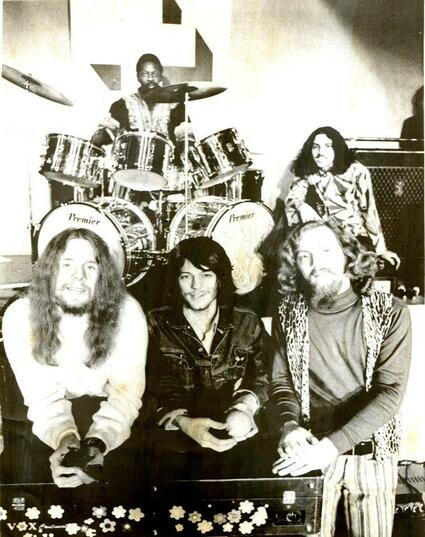 The Mind Garage The Mind Garage The first televised rock worship service, a half-century ago, had all of the earmarks of Contemporary Christian Music today and all of the loud warning signs for wise, Bible-believing Christians and churches. The date was April 27, 1969, the year I entered the U.S. Army. The band was The Mind Garage; the broadcaster was ABC (American Broadcasting Corporation); the forum was Saint Mark’s Episcopal Church in Bowery, Manhattan. The event was called “14th Electric Mass.” It was seen by thousands of people in the United States and rerun annually into the 1980s (classicchristianrockzine.com). Consider the earmarks of this proto-rock worship service: First, from its inception rock worship was pagan in sound. The music of the first rock worship band was borrowed directly from the secular world. There was nothing sacred or holy about it. It was described as “psychedelic,” which was 1960s drug music. Journalist Joyce Tracewell described it as “deliberate alien music, the kind that makes you shiver.” She said “they sing in voices that should have belonged to Druids or Incas or Gypsies” (“Mind Garage Deliberate Alien Music,” Mindgarage.com, Apr. 19, 1970). I know this music. I lived this music as a drug-using “hippie” before I was saved. There is nothing godly about it. It is “spiritual” only in the sense that it is of the spirit of this world. From then until now, Contemporary Christian Music has borrowed at its pleasure from the cesspool of the world’s party music, pretending to have this liberty, but it is not a liberty justified by God’s Word. It is confusion; it is apostasy; it is rebellion to incorporate the sexualized, demon-influenced music styles of this wicked world into the worship of a thrice-holy God, the God who has commanded His people, “Be not conformed to this world” (Ro. 12:2). Second, from its inception rock worship was ecumenical. The Mind Garage Band members were Baptist, Catholic, and Protestant. “It was not uncommon to witness Episcopalians, Catholics, Protestants and Jews together, all taking Communion” (“The Electric Liturgy of ‘The Mind Garage,’” Classic Christian Rockzine, 2015). The Mind Garage performed in Episcopal, Catholic, Presbyterian, Baptist, and Methodist churches. Ecumenism requires an unscriptural non-judgmental stance toward doctrine and practice and an openness of heresy and apostasy. Nothing is building a “one world church” more effectively than Contemporary Christian Music. Even the more conservative contemporary worship people, such as the Gettys, are ecumenical (e.g., their non-critical relationship with Roman Catholic Matt Maher). It is telling that the first televised rock worship service was held in an Episcopal congregation, seeing that the Episcopalians have been on the cutting edge of theological modernism and apostasy. Earlier in the 1960s, Episcopalian Bishop James Pike called the virgin birth of Christ a “primitive myth” and said that Joseph was probably Jesus’ real father (Redbook magazine, August 1961). He also said that Adam and Eve, the Garden of Eden, heaven, and hell are myths. In 1963, Episcopal theologian Paul van Buren started the God-is-dead movement with the publication of The Secular Meaning of the Gospel. Third, from its inception rock worship was worldly. The longhaired men of The Mind Garage “were not overly religious” and cared little to nothing about biblical precepts against unisex and immodest fashion, alcohol and drug use, separation from filthy things such as secular rock music. The Mind Garage associated with and performed with filthy bands such as Iron Butterfly, Sly and the Family Stone, and Canned Heat. In practice, they ripped verses such as the following from their Bibles: Romans 12:2; 1 Corinthians 11:14-15; 2 Corinthians 6:14-18; Ephesians 5:11; 1 Timothy 2:9; James 4:4; and 1 John 2:15-17. Worldliness continues to be a prominent feature of Contemporary Christian Music, as we have documented in Baptist Music Wars and A Directory of Contemporary Worship Musicians, both of which are available as free eBooks from www.wayoflife.org. Fourth, from its inception rock worship was focused on a feeling. A Mind Garage advertisement said, “We welcome you to the electric liturgy, a festival of feeling.” We are reminded that from its inception, contemporary Christian music has been experience oriented, which is largely a product of its intimate association with the charismatic movement. Contemporary worship music is a rock & roll feeling-fest. It is designed to create an emotional experience, a sensual experience, as opposed to a sacred music style that edifies through the mind and heart. We are taught to learn of Christ, not feel Christ (Mt. 11:28-30). But Graham Kendrick, one of the biggest names in contemporary worship, says, “The old way of preaching and singing began to give way to an expectation that ... God would visit us, and we’d EXPERIENCE HIS PRESENCE IN A TANGIBLE SORT OF WAY” (interview June 11, 2002 with Chris Davidson of Integrity Music). Hillsong United’s Matt Crocker says, “My goal is to create an atmosphere for people to be able to enter into the presence of God” (“Seeing the World in Wonder with Hillsong United’s Matt Crocker,” WorshipMusician.com, Jul. 21, 2017). The search for feeling in worship drives the choice of a rock style of music. Unlike traditional sacred music styles, rock music produces strong sensual feelings. One rock song writer well described it as being “hooked on a feeling.” A Bible-believing church that is playing with contemporary Christian music is playing with fire. It is building bridges to the one-world “church” and to the world itself, bridges that will eventually destroy whatever biblicist, pilgrim character the church currently possesses. (Friday Church News Notes, May 10, 2019, www.wayoflife.org, [email protected], 866-295-4143) Comments are closed.
|
Archives
February 2020
|
Ads do not imply endorsement | Policy/Terms of Service | About Us | Contact Us | © Life Work Academy, Inc.
 RSS Feed
RSS Feed

